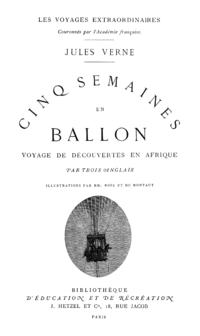Five Weeks in a Balloon
|
Title page of a Hetzel edition | |
| Author | Jules Verne |
|---|---|
| Original title | Cinq semaines en ballon |
| Translator | William Lackland |
| Illustrator |
Édouard Riou and Henri de Montaut |
| Country | France |
| Language | French |
| Series | The Extraordinary Voyages #1 |
| Genre | Adventure novel |
| Publisher | Pierre-Jules Hetzel |
Publication date | 1863 |
Published in English | 1869 |
| Media type | Print (Hardback) |
| Followed by | The Adventures of Captain Hatteras |
Five Weeks in a Balloon, or, Journeys and Discoveries in Africa by Three Englishmen (French: Cinq semaines en ballon) is an adventure novel by Jules Verne, published in 1863. It is the first novel in which he perfected the "ingredients" of his later work, skillfully mixing a plot full of adventure and twists that hold the reader's interest with passages of technical, geographic, and historic description. The book gives readers a glimpse of the exploration of Africa, which was still not completely known to Europeans of the time, with explorers traveling all over the continent in search of its secrets.
Public interest in fanciful tales of African exploration was at its height, and the book was an instant hit; it made Verne financially independent and got him a contract with Jules Hetzel's publishing house, which put out several dozen more works of his for over forty years afterward.
Plot summary
A scholar and explorer, Dr. Samuel Ferguson, accompanied by his manservant Joe and his friend professional hunter Richard "Dick" Kennedy, sets out to travel across the African continent — still not fully explored — with the help of a balloon filled with hydrogen. He has invented a mechanism that, by eliminating the need to release gas or throw ballast overboard to control his altitude, allows very long trips to be taken. This voyage is meant to link together the voyages of Sir Richard Burton and John Hanning Speke in East Africa with those of Heinrich Barth in the regions of the Sahara and Chad. The trip begins in Zanzibar on the east coast, and passes across Lake Victoria, Lake Chad, Agadez, Timbuktu, Djenné and Ségou to St Louis in modern-day Senegal on the west coast. The book describes the unknown interior of Africa near modern-day Central African Republic as a desert, when it is actually savanna.

A good deal of the initial exploration is to focus on the finding of the source of the Nile, an event that occurs in chapter 18 (out of 43). The second leg is to link up the other explorers. There are numerous scenes of adventure, composed of either a conflict with a native or a conflict with the environment. Some examples include:
- Rescuing of a missionary from a tribe that was preparing to sacrifice him.
- Running out of water while stranded, windless, over the Sahara.
- An attack on the balloon by condors, leading to a dramatic action as Joe leaps out of the balloon.
- The actions taken to rescue Joe later.
- Narrowly escaping the remnants of a militant army as the balloon dwindles to nothingness with the loss of hydrogen.
- An anachronistic killing of a Bluebuck antelope, a species which was already extinct.[upper-alpha 1]*
In all these adventures, the protagonists overcome by continued perseverance more than anything else. The novel is filled with coincidental moments where trouble is avoided because wind catches up at just the right time, or the characters look in just the right direction. There are frequent references to a higher power watching out for them.
The balloon itself ultimately fails before the end, but makes it far enough across to get the protagonists to friendly lands, and eventually back to England, therefore succeeding in the expedition. The story abruptly ends after the African trip, with only a brief synopsis of what follows.
Similarities to later novels
Five Weeks has a handful of similarities to the novel Journey to the Center of the Earth. There is the same sort of conjecture from current scientific ideas and what Verne puts forth as the actual truth (though Five Weeks is far more successful, assuming there is any attempt at accuracy with Journey). The party of three characters is similarly divided into the Doctor, the doubtful companion who initially balks at the journey, and the servant who is quite able. In both novels, Purdey rifles are referenced. In both novels, there is an episode of despair characterized by thirst.
Film adaptations
- 1961 - Flight of the Lost Balloon USA directed by Nathan Juran and starring Marshall Thompson. Due to pressure from Irwin Allen and 20th Century Fox all references to Jules Verne were dropped from the film.[2]
- 1962 - Five Weeks in a Balloon, USA, directed by Irwin Allen and starring Red Buttons, Fabian, Barbara Eden, Sir Cedric Hardwicke, Peter Lorre, Richard Haydn, Barbara Luna (see Five Weeks in a Balloon at the Internet Movie Database)
- 1975 - Viaje Fantástico en Globo, Mexico, directed by René Cardona Jr and starring Hugo Stiglitz (see Viaje Fantástico en Globo at the Internet Movie Database)
References
Notes
Citations
- ↑ Verne 2015, p. 75.
- ↑ p.234 Taves, Brian, Michaluk, Stephen & Baxter, Edward The Jules Verne Encyclopedia Scarecrow Press, 1996
Sources
- Verne, Jules (2015) [1863]. Five Weeks in a Balloon. Paris, France: Pierre-Jules Hetzel. p. 75. ISBN 978-1-5168-5211-6. Retrieved June 13, 2016.
External links
| French Wikisource has original text related to this article: |
| Wikimedia Commons has media related to Five Weeks in a Balloon. |
 Works related to Five Weeks in a Balloon at Wikisource
Works related to Five Weeks in a Balloon at Wikisource
- Cinq semaines en ballon at Project Gutenberg (French)
-
 Five Weeks in a Balloon public domain audiobook at LibriVox
Five Weeks in a Balloon public domain audiobook at LibriVox
